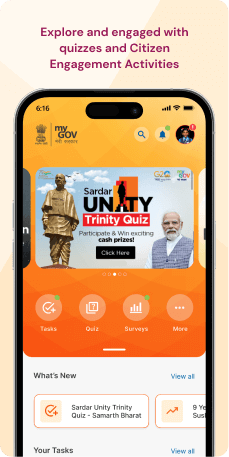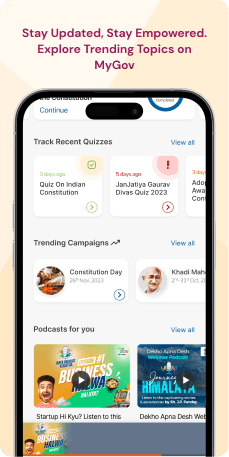introduction
The MyGov mobile app, an initiative by the Government of India, is designed to enhance citizen engagement and participation in governance. It facilitates the sharing of ideas and enables citizens to contribute to various initiatives, fostering a collaborative and inclusive approach to governance. The MyGov application plays a crucial role in bridging the gap between the government and its citizens, promoting transparency, and encouraging a sense of shared responsibility in the decision-making process.
Objective
The MyGov mobile app's core objective is to enhance citizen engagement, participation, and collaboration in the governance and decision-making of the Government of India. It seeks to bridge the government-citizen gap, enabling active contributions to policymaking and developmental initiatives.
- Citizen Engagement- The application empowers citizens to actively participate in discussions on various topics related to governance, policies, and development. Users can share their perspectives and suggestions on different government initiatives.
- Campaigns and Contests- MyGov frequently organizes campaigns and contests to stimulate citizen involvement in specific projects or societal issues. These initiatives encompass challenges related to innovation, awareness, and community development.
- Policy Feedback- The application provides a platform for citizens to offer feedback on proposed policies and initiatives. This promotes inclusivity and allows the government to consider public opinions in the decision-making processes.
- Information Dissemination- Users can receive real-time updates and information about government programs, policies, and announcements directly through the app. This ensures that citizens stay informed about the latest developments.
- Task and Project Participation- MyGov invites citizens to actively contribute to specific tasks or projects, harnessing the collective intelligence and skills of the population for the betterment of society.
- Surveys and Polls- MyGov conducts surveys and polls to gauge public opinion on specific matters. The data collected through these surveys can be utilized by the government to make well-informed decisions.
Target Audience
The MyGov mobile application predominantly targets Indian citizens, appealing to a diverse audience, including the public, government officials, policy makers, students, educators, innovators, entrepreneurs, community leaders, and non-governmental organizations. The application aims to create a more participatory and inclusive form of governance, reaching out to individuals from various backgrounds and walks of life. It serves as a platform for civic engagement, fostering collaboration, and contributing to the development of communities and the nation.
The Challenge
The challenges faced by the MyGov mobile application include the digital divide, technological barriers, language diversity, awareness and outreach issues, data privacy concerns, feedback implementation hurdles, sustaining citizen engagement, unequal participation, policy alignment, and the need for monitoring misuse. Addressing these challenges requires a comprehensive approach involving technology improvements, education efforts, effective communication, transparency, and continuous monitoring.
Usability Study Findings
The usability study highlighted disparities in onboarding, the absence of a pre-sign-in tour, feedback issues post-dismissal, platform inconsistencies, and potential cognitive overload due to excessive visuals in the MyGov application-
Login Screen- Varied Experiences for OTP and Email Users- The MyGov mobile application encounters inconsistency in onboarding experiences. While mobile number authentication is a straightforward two-step process with OTP verification, email-based sign-in involves a more complex four-step procedure. This disparity introduces potential confusion, requiring a streamlined approach to ensure a consistent and user-friendly onboarding journey for all users.
- Absence of Pre-Sign-In Tour- A critical oversight in the MyGov mobile app's user experience is the absence of a pre-sign-in tour. This tour is vital for introducing users to the application seamlessly. Without it, new users may navigate the application without a comprehensive understanding of its features, functionalities, and purpose, hindering effective engagement. Incorporating a guided tour is imperative to address this gap and enhance overall user comprehension.
- Lack of Feedback on Dismissing "Update Profile" Pop-Up- The MyGov mobile application faces a usability concern regarding the lack of clear feedback when users dismiss the "Update Profile" pop-up on the home screen. After dismissal, users receive no visible reminders or indications elsewhere in the interface. This poses a challenge as users may overlook profile updates, resulting in incomplete or outdated user profiles. Implementing a persistent indicator on the home screen post-dismissal is recommended to remind users and promote consistent profile maintenance.
- Ensuring Consistency Between MyGov Mobile Application and Mobile Web Experience- Maintaining consistency between the MyGov mobile application and its mobile web counterpart is pivotal. Disparities between the two platforms in design elements, functionalities, and overall user experience can impact user satisfaction. Conducting a thorough audit to identify and rectify these disparities ensures a seamless transition for users, fostering a more intuitive and cohesive experience across both platforms.
- Mitigating Cognitive Load-A significant concern in the MyGov mobile app's user interface is the excessive use of contrasting colors and images. While visuals can enhance engagement, the current abundance may overwhelm users, leading to cognitive fatigue and difficulty in focusing on essential information. A comprehensive design audit is recommended to rationalize the use of colors and images, promoting a more balanced, user-friendly interface that reduces cognitive load and encourages active user participation.
Improve the user experience by streamlining onboarding, maintaining consistent design and by providing clear visual cues. Boost engagement by resolving the pain points, prompting profile updates, and ensuring a unified experience across platforms. Aim for a visually balanced and simple interface to minimize cognitive load, fostering a more user-friendly interaction. Implementing these enhancements will align the MyGov mobile application with its goal of promoting citizen engagement and participation in governance.
Synthesizing Phase
With the insights gathered during the research phase, we have gained valuable understanding of the users' interactions and challenges while using the application of the MyGov, Government of India. Building on this knowledge, we have now entered the Defining phase, where our aim is to deepen our comprehension and transform the research findings into practical design solutions. To maintain a user-centric approach, we have created personas that embody essential user archetypes-
User Personas Persona 1-Renuka, a Rural EducatorRenuka, a dedicated rural educator, seeks to utilize the MyGov mobile application to enhance civic awareness and engagement among the students and parents in her community.
Goals-Her primary goal is to bridge the digital divide by encouraging participation in discussions related to education policies and developmental initiatives. Renuka also aims to leverage the application for disseminating information about government programs and policies to ensure that her community stays informed about educational opportunities and initiatives.
Pain Points-Renuka faces challenges related to the digital divide, as access to smartphones and the internet is limited in her rural community. Additionally, language diversity poses a hurdle, as some community members may not be proficient in the dominant languages used on the app. Awareness and outreach issues are significant concerns, as Renuka must overcome skepticism and build trust in the app's potential benefits. Balancing data privacy concerns, especially among parents, while encouraging active participation in surveys and polls is another challenge she anticipates.
Persona 2- Arjun, an Urban EntrepreneurArjun, a young urban entrepreneur, sees the MyGov mobile application as an opportunity to actively contribute to policies related to business and innovation.
Goals-His primary goal is to engage in discussions and provide constructive feedback on government initiatives that impact the entrepreneurial ecosystem. Arjun aims to participate in contests and campaigns related to innovation and community development. By doing so, he hopes to influence policies that foster a conducive environment for startups and small businesses.
Pain Points-Arjun confronts technological barriers, as some of the government's digital initiatives might not align seamlessly with his business operations. Unequal participation is a challenge, as Arjun perceives that certain segments of society may dominate discussions, leaving the voices of smaller entrepreneurs unheard. Policy alignment is crucial for Arjun, and he faces the challenge of ensuring that the policies proposed align with the dynamic needs of the entrepreneurial sector. Additionally, monitoring misuse on the platform is essential to maintain the integrity of discussions and prevent malicious activities that could hinder genuine contributions.
Mapping User Journey and Extracting InsightsArjun discovers the MyGov mobile application through social media and online forums, intrigued by the opportunity to contribute to policies affecting the entrepreneurial ecosystem. During the onboarding process, he encounters challenges related to technological barriers, such as compatibility issues with certain devices. Navigating the app, Arjun faces difficulties in finding specific discussions and contests relevant to his interests. Connectivity issues occasionally disrupt his engagement, hampering his ability to participate in real-time discussions and polls.
As Arjun strives to actively contribute, he occasionally encounters unequal participation, with certain dominant voices overing smaller entrepreneurs. Despite these challenges, he continues to participate in campaigns and contests related to innovation and business development. However, policy alignment becomes a crucial concern for Arjun, as he wants to ensure that the proposed policies cater to the dynamic needs of the entrepreneurial sector.
Arjun's User Story"As an urban entrepreneur passionate about contributing to policy discussions, I want a seamless and inclusive experience on the MyGov app, ensuring that my voice is heard, and policies align with the diverse needs of the entrepreneurial ecosystem."
Framing challenges and hypothesisAnalyzing Arjun's journey reveals challenges related to technological barriers, navigation difficulties, unequal participation, and policy alignment. Crafting a problem statement encapsulates these challenges.
Problem Statement"Arjun, an urban entrepreneur, faces obstacles in actively contributing to policy discussions on the MyGov application due to technological barriers, navigation difficulties, unequal participation, and concerns about policy alignment with the dynamic needs of the entrepreneurial sector."
Hypothesis Statement"If the MyGov application addresses technological barriers, enhances navigation, ensures equal participation, and focuses on policies aligned with the diverse needs of the entrepreneurial sector, Arjun's experience will become more seamless and satisfying, fostering increased engagement and meaningful contributions to policy discussions."



